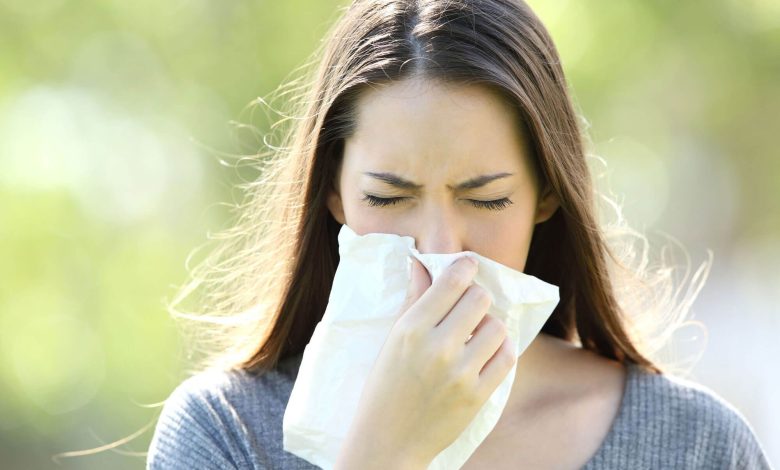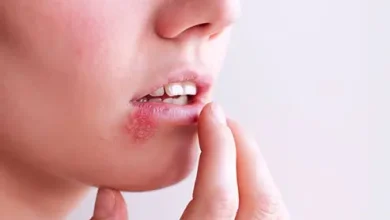6 Subtle Symptoms of Fall Allergies You Might Be Ignoring, According to Experts

As the leaves turn golden and pumpkin spice takes over everything from lattes to candles, autumn arrives with its crisp air and cozy vibes. But for millions of people, fall also brings something far less pleasant—allergies. While many associate sneezing and itchy eyes with springtime pollen, allergy specialists warn that fall allergies can be just as severe, and often sneak up in surprising ways.
According to experts, the tricky part about fall allergies is that their symptoms often masquerade as colds, flu, or fatigue from changing weather. If you find yourself feeling run-down every autumn without knowing why, your body may actually be reacting to allergens like ragweed pollen, mold spores, or dust mites.
6 Subtle Symptoms of Fall Allergies
6 subtle symptoms of fall allergies you might be ignoring, what causes them, and how to manage them effectively—straight from medical experts and allergists.
1. Persistent Fatigue or Brain Fog
You might think your tiredness is due to busy schedules, darker days, or lack of sleep—but chronic fatigue and brain fog are often linked to allergies.
Why It Happens
When your body encounters allergens like ragweed pollen or mold, your immune system releases chemicals called histamines to fight them off. This immune response causes inflammation throughout your body, even in your sinuses and airways.
The result? You may experience sleep disturbances, poor oxygen intake, and general inflammation, all of which contribute to feeling sluggish and mentally foggy.
Dr. Payel Gupta, an allergist and immunologist with the American College of Allergy, Asthma & Immunology (ACAAI), explains:
“Allergies don’t just affect your nose—they impact your whole body. When you’re congested and not breathing properly, your sleep quality suffers. Over time, that leads to fatigue, headaches, and trouble focusing.”
How to Tell It’s Allergies
- You feel fine during other seasons but sluggish in the fall.
- You experience congestion or sinus pressure along with fatigue.
- Antihistamines temporarily make you feel more alert.
Expert Tip
Invest in an air purifier with a HEPA filter, especially for your bedroom. It can reduce airborne allergens and help improve sleep quality dramatically.
2. Itchy, Watery Eyes (Even Indoors)
Red, watery, or itchy eyes are classic allergy symptoms—but what many people overlook is when and where these symptoms occur. Fall allergies can make your eyes irritated even when you’re inside your home.
Why It Happens
The main culprit in autumn is ragweed pollen, which can travel hundreds of miles through the air. Additionally, as temperatures drop and you start heating your home, dust mites and mold spores become active indoors.
These irritants trigger your eyes’ histamine response, causing itching, burning, and excessive tearing.
Dr. Clifford Bassett, an allergist at New York University, says:
“Your eyes are exposed surfaces. Even small amounts of airborne allergens can settle on your eyelashes or contact lenses, leading to irritation that many mistake for eye strain or dryness.”
How to Tell It’s Allergies
- Your eye discomfort worsens when windows are open or when you’re near leaves or damp areas.
- You notice symptoms at the same time each year.
- Artificial tears or allergy eye drops relieve the irritation.
Expert Tip
Try a cold compress on your eyes to soothe inflammation, and wash your pillowcases weekly in hot water to remove allergens.
3. A Lingering Cough or Sore Throat
If you’ve been battling a cough that won’t go away, especially at night, allergies may be the hidden cause.
Why It Happens
When allergens like pollen or mold irritate your nasal passages, your body produces excess mucus. This mucus drips down the back of your throat, known as postnasal drip, which causes throat irritation, coughing, and hoarseness.
Dr. Neeta Ogden, an allergy specialist, explains:
“Postnasal drip is one of the most under-recognized symptoms of allergies. People often think they have a cold, but if it lingers for weeks and doesn’t progress, allergies are a likely culprit.”
How to Tell It’s Allergies
- Your cough is dry or tickly rather than productive.
- You don’t have a fever or body aches.
- Symptoms worsen at night or after being outdoors.
Expert Tip
Using a saline nasal rinse or neti pot daily can help flush out allergens and reduce throat irritation. Avoid using tap water; instead, use distilled or sterile water to prevent infection.
4. Increased Headaches or Sinus Pressure
If you’re suddenly getting more headaches in the fall, it might not be stress—it could be your sinuses reacting to allergens.
Why It Happens
Allergens trigger inflammation in the sinus cavities, leading to pressure build-up behind the eyes, cheeks, and forehead. This pressure can cause headaches that feel dull, throbbing, or even mimicking migraines.
Dr. Lakiea Wright, medical director at Thermo Fisher Scientific, notes:
“Fall allergens cause swelling of nasal tissues, which can block normal sinus drainage. The pressure that builds up often manifests as headaches or facial pain.”
How to Tell It’s Allergies
- You feel pressure in your forehead or around your eyes.
- The pain worsens when bending forward.
- Over-the-counter allergy medication offers relief.
Expert Tip
A warm compress over the sinuses can help relieve congestion and pressure. Keeping your home’s humidity between 35% and 50% with a humidifier can also prevent your nasal passages from drying out.
5. Dry, Itchy Skin or Eczema Flare-Ups
While we often think of allergies affecting our airways, they can also wreak havoc on your skin—especially in fall when indoor heating kicks in.
Why It Happens
Cool, dry air combined with allergens like dust mites and mold can strip moisture from your skin and trigger immune reactions. People with conditions like eczema (atopic dermatitis) are especially prone to flare-ups this time of year.
Dr. Whitney Bowe, a dermatologist in New York City, explains:
“When your skin barrier is compromised, allergens can penetrate more easily, leading to inflammation, redness, and itching. Fall is the perfect storm—less humidity, more indoor allergens, and constant temperature changes.”
How to Tell It’s Allergies
- You develop itchy patches on your hands, face, or elbows.
- Your skin feels tight or flaky despite moisturizing.
- Symptoms flare up after cleaning, dusting, or being around pets.
Expert Tip
Switch to fragrance-free moisturizers and apply them immediately after showering. A humidifier can help maintain skin hydration and reduce airborne dust.
6. Ear Fullness or Mild Dizziness
Feeling like your ears are plugged, or experiencing brief bouts of dizziness? It could be due to sinus congestion caused by allergies, not an ear infection or dehydration.
Why It Happens
The Eustachian tubes, which connect your middle ear to your throat, help regulate pressure. When allergies cause nasal inflammation, these tubes can become blocked, resulting in that annoying sensation of ear fullness, popping, or mild vertigo.
Dr. Sandra Lin, chair of Otolaryngology at Jefferson Health, explains:
“Allergic inflammation can affect the Eustachian tubes, leading to fluid buildup and imbalance. It’s especially common in the fall when both pollen and mold counts are high.”
How to Tell It’s Allergies
- Your ears feel clogged but aren’t painful.
- You experience popping sensations when swallowing or yawning.
- The symptoms come and go depending on weather or location.
Expert Tip
Try gentle steam inhalation to reduce sinus congestion and promote drainage. Over-the-counter decongestants can also help, but should be used sparingly to avoid rebound congestion.
Bonus: Why Fall Allergies Are Often Overlooked
Experts say many people mistake fall allergy symptoms for the common cold, flu, or seasonal fatigue—especially since these conditions share overlapping signs like congestion, sore throat, and headaches.
However, there are key differences:
- Colds typically last 7–10 days and may include fever.
- Allergies can persist for weeks or even months as long as allergens are present.
- Allergies don’t cause fever or body aches, and symptoms improve with antihistamines.
Dr. Gupta notes,
“If your symptoms show up at the same time every year and last more than two weeks, it’s probably allergies—not a cold.”
Common Fall Allergy Triggers to Watch For
Understanding the sources of fall allergens can help you reduce exposure and control symptoms effectively.
1. Ragweed Pollen
- Peaks from late August through October.
- One plant can release a billion pollen grains carried by wind for miles.
2. Mold Spores
- Grow in fallen leaves, compost piles, and damp areas.
- Thrive during rainy or humid fall days.
3. Dust Mites
- Multiply when heating systems are turned on after summer.
- Found in bedding, carpets, and upholstery.
4. Pet Dander
- As pets spend more time indoors during colder weather, exposure increases.
- Allergic reactions can intensify even if you’ve lived with pets for years.
Expert-Approved Remedies and Prevention Tips
Managing fall allergies doesn’t have to mean suffering through every autumn. Here’s what allergists recommend to minimize symptoms and improve your quality of life:
1. Monitor Local Pollen Counts
Check daily pollen forecasts through apps or weather websites. On high-pollen days, keep windows closed, especially during early morning and evening hours when pollen counts are highest.
2. Practice Smart Cleaning Habits
- Use a vacuum with a HEPA filter.
- Wash bedding weekly in hot water.
- Reduce clutter where dust can collect.
- Avoid drying clothes outside during peak pollen season.
3. Take Preventive Medication
Antihistamines, decongestants, or nasal corticosteroid sprays can help manage symptoms. Talk to your doctor before starting any new treatment, especially if you have preexisting conditions.
4. Shower After Outdoor Activities
Pollen can stick to your skin, hair, and clothes. A quick shower after spending time outside can prevent allergens from spreading indoors.
5. Strengthen Your Immune System
A healthy lifestyle can make a big difference in how your body handles allergens.
Focus on:
- Adequate sleep (7–8 hours per night)
- A balanced diet rich in antioxidants
- Regular exercise
- Staying hydrated
6. Consider Allergy Testing
If symptoms persist, see an allergist for skin or blood tests. Knowing your specific triggers can help you take targeted steps, like immunotherapy or specialized avoidance strategies.
When to See a Doctor
If your symptoms interfere with your daily activities, affect your sleep, or lead to chronic sinus infections, it’s time to consult a healthcare professional. Persistent allergy symptoms can worsen asthma, cause sinus complications, and reduce overall well-being.
Seek immediate help if you experience:
- Shortness of breath or wheezing
- Severe sinus pain
- Ear pain or hearing changes
- Swelling around the eyes or lips
Conclusion: Listen to Your Body This Fall
Fall allergies can be stealthy, often mimicking other seasonal illnesses. But paying attention to the subtle signs—like fatigue, itchy eyes, or persistent cough—can help you catch them early and take control before symptoms worsen.
As Dr. Bassett aptly says,
“Awareness is your best defense. Once you know what triggers your allergies, you can adapt your environment and habits to breathe—and live—more comfortably.”
So, the next time you feel off as the weather cools down, don’t just blame it on the season. Your body might be telling you it’s time to address your fall allergies head-on—and enjoy autumn without the sniffles and fatigue.




